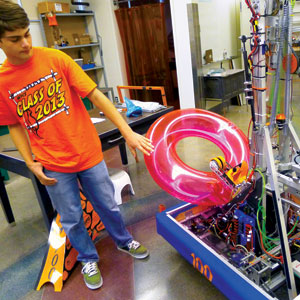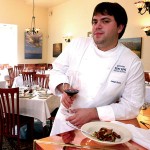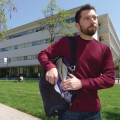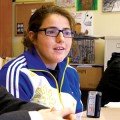Geoff Diesel sits behind a desktop-size mixing board. The indie rocker, DJ and bookish English instructor, 41, has drawn on all of his personas in his current job, teaching an audio production class at Woodside High School as part of a Career Education Training program. Using the industry-standard recording software Pro Tools, Diesel’s class sessions would cost students more than $5,000 off campus.
“They come in being victims of technology, having the technology using them,” Diesel says. “I’m trying to turn that around. I tell them, ‘Learn how to control it.’ By the time they leave they’ll be able to go into a startup, and with their knowledge and creativity they can bring a lot to an organization.”
The audio production class is the brainchild of Woodside Principal David Reilly, who has taken the lead in searching for new ways to engage students at his school. Reilly and the faculty here embrace technology as the great equalizer;a tool that allows everyone in the school’s vast economic spectrum to create, calculate and communicate. At a time when public schools across the state are seeing their funding evaporate, the administration and faculty of Woodside have become very aggressive about pursuing grants. That tenacity has borne results.
Applying for a California matching grant, for which more than 100 schools competed, Woodside was awarded $3 million before raising its equal share of the grant. The school also received $1.5 million from the district and will soon break ground on a $7.5 million digital-media center next year.
Reilly envisions the center as a digital-media home, where the student body forms into a sort of mini production company. Projects will range from film documentaries to podcasts through standard journalism practices, as well as photography, video and audio.
Principal Reilly would like to see the new building, designed with an empty center, to serve as a collaborative space with soundproof windows so teachers can dispatch the audio production students to work with video production and collaborate. All this from a school that was called stuck in the 1950s by the documentary Waiting for Superman, a film highly critical of public education.
Woodside has also received $265,000 worth of free equipment from Hewlett-Packard as part of HP’s Catalyst Initiative program, which is designed to boost STEM education, an acronym for education in science, technology, engineering and math. The HP donation has changed the direction of numerous classes on campus, prompting curriculum updates by a faculty not afraid of change.
For instance, in an outdoor classroom that’s part of the student-farmed vegetable patch, the environmental chemistry students learn how to operate more up-to-date tools than a hoe. Instructor Ann Akey has her class use HP laptops and digital probes to measure soil temperature.
The HP Catalyst Initiative’s website states that the grants were created to deal with a shortfall in STEM education. Their program has funded projects in 12 countries around the world to date, from Woodside to Beijing, and encourages the collaboration of research between its recipients.
Teacher David Shannon has watched calculus students at WHS transition from doing math with chalk and a blackboard to learning calculus on HP Minis. Now students work individually and the computer shows them an error in their calculations. If they have further problems, they can click on a digital tutor.
“The classroom of today is not the one that we or our parents were in,” Shannon says. “For many classes there are no walls. The classroom is wherever we take it. We are bringing the working world into the high school for our students.”
{pagebreak}
Grant Race
Arlene Kolber has been teaching at Woodside for 44 years, and today she runs the school’s robotics team, which works evenings and weekends to build a robot. Last year’s crew used its cache of HP computers to build the award-winning G-Wrath, a long-necked giraffelike contraption that can catapult objects across the field.
Students involved in the robotics team take their inventions to local and national competitions, and many of the budding inventors are planning to pursue engineering degrees after graduation. Watching her students spend time with technology, Kolber has seen a shift in attitude, especially for at-risk students. “The robotics program has taken kids who would have been off the bus and changed them,” she says. While the school is located in one of the wealthiest towns in the Bay Area, school officials say 52 percent of Woodside students are on the free lunch program.
The school’s furious chase for grants, which has already led to the creation of a $55,000 recording studio, grew out of a boyhood friendship in Albany, New York, between Diesel and Principal Reilly.
They both wound up moving to San Francisco; in their 20s, the two friends formed a band called Moe Road, so named because all of its members lived along this eponymous route. Diesel and Reilly later learned Pro Tools to produce music in their living rooms, then took their tracks down to Hyde Street Studios to record in the same space where the Grateful Dead created albums.
Along the way, Diesel became a high school English teacher and convinced his buddy it was a good opportunity offering a flexible schedule. Reilly, who is also a spoken-word poet, now runs the show at Woodside High.
“If these kids graduate high school with the skills we were developing in our 20s, they’ll have such a head start on the whole business,” Reilly says. He sees the advantage for students graduating in the heart of Silicon Valley with an employable skill set, the type of goal Career Education Training was designed to accomplish.
Reilly is sensitive to claims that technology is corrupting today’s youth, particularly a New York Times article that focused on Woodside High last year. The article argued that constant interaction with computers destroys students’ ability to focus. “Technology is really just an extension of ourselves,” Reilly says. “If you’re a person who’s very social, the technology’s just going to magnify that tendency in you. If you’re very cerebral or creative, you might make records or become a music producer.
“To label technology as having an adverse effect is a very sort of lazy judgment. The responsibility I have as an educator is to create learning opportunities where the right tendencies get magnified.”

 Live Feed: Fall Flavors
Live Feed: Fall Flavors  Golden State Warriors Plan SJ Charity Event
Golden State Warriors Plan SJ Charity Event 









